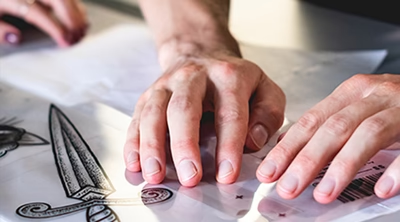A Comprehensive Guide to Eco-Friendly Screen Printing

Screen printing is a well-known and versatile technique used in various industries, from fashion to signage. However, the traditional screen printing process can have negative environmental impacts due to the chemicals and materials used. Due to this, many businesses and individuals are now exploring eco-friendly screen printing practices.
These sustainable methods reduce the environmental footprint and align with the growing demand for greener alternatives in the industry. In this guide, you will look at various eco-friendly printing techniques and tools that can help you minimize waste, save resources, and make responsible choices while still achieving high-quality prints.
Techniques for Eco-Friendly Screen Printing?
There are various techniques to execute eco-friendly screen-printing practices. Some of these are:
Recycling Film Positives
You can utilize film positives to cover pinholes instead of throwing them in the dustbin. Additionally, you can use film positives to block the artwork rather than wrapping the tape. If you don't like reusing it, you'll think of throwing it in the trash. But if you recycle it, that'll be the best.
Use Eco-Friendly Cleaning Material
Eco-friendly cleaning material includes citrus-based chemicals and soybeans, eco-friendly degreasers, washes, openers, strippers, and pallet paste. These are all environment-friendly removers and can be easily used without any harm.
Use a Water Filtration System
A water filtration system preserves the environment by fixing a water conduit system that captures solids from ink and emulsion. The wash booth filtration system is designed to remove solids that clog the pipe and further dissolve in water, making it toxic.
Reusing Old or Misprinted T-Shirts
Despite throwing misprints old t-shirts in the trash, they can be reused for clean-up purposes. You can recycle T-shirts, as these are environmentally friendly. It's an excellent option to reuse printed T-shirts and give them another life.
Use Less Water
You can use a spray bottle to start the screen-printing development process. It helps stop the exposure process and allows the stencil to begin developing by making the emulsion soft. Give it time, then use a spray bottle to moisten the rest.
Make use of a dip tank to reclaim and develop your screens. With the help of a dip tank, you can reduce the amount of water being used and reuse water each time you develop a screen.
Stop Using Single Inks Scrapers
By using a single-use scraper, you are generating more landfill and trash. So, switch to an ink spatula or a scraper that can be washed and used again to scrap off the ink.
Eco-Friendly Screen-Printing Tools
There are various eco-friendly printing tools, which include eco-friendly printers, inks, removers, and pallet adhesives used to eliminate stains and clean ink from the emulsion.
Squeegees with Wood Handles
Use a squeegee with wood handles as these are reusable and help to eliminate waste. These are eco-friendly and plastic–free. When selecting an eco-friendly squeegee, you can consider eco-friendly squeegee made from recycled material.
DTF Printer
DFT printers are considered more eco-friendly than any other printers as they require fewer chemicals and produce less waste. It doesn't require chemicals to eliminate ink from screens, which make hazardous waste and harm the environment.
Pallet Adhesives:
These are eco-friendly products and have characteristics such as low volatile organic compounds. VOCs contribute to air pollution and leave adverse health effects. Most eco-friendly pallets are water-based, which means they contain fewer chemicals.
Explore Eco-Friendly Screen Printing Inks
There are various kinds of eco friendly screen printing ink, which include water-based inks, soy inks, UV inks, etc.
Water-based inks
Water-based inks are alternatively referred to as soft lays and are considered eco-friendly printing ink. These inks utilize water as their primary solvent and comprise a pigment, a non-ionic surfactant, and distilled water.
Soy inks
Nowadays, Soy inks (plant-based inks) are used more frequently and made from soybeans. Two methods can make it: firstly, by refining soybeans into oil, and another by mixing the oil with pigment and waxes.
UV inks
UV inks are specifically designed to dry when exposed to UV light rather than oxidation (air). These unique inks dry considerably more quickly than traditional ones, producing more apparent and colourful pictures.
Final Verdict
In short, you must adopt eco-friendly screen-printing practices to preserve the environment. Screen printing is a famous worldwide business, and it's your choice to opt for eco-friendly methods and tools in your everyday lives. So, step towards saving the environment and proceed with eco-friendly printing practices.


.webp)


Comments
Post a Comment